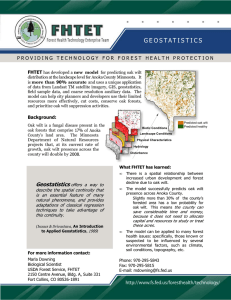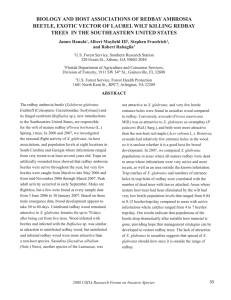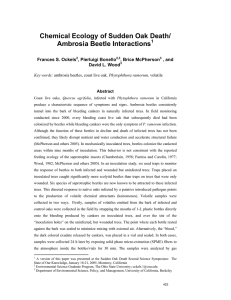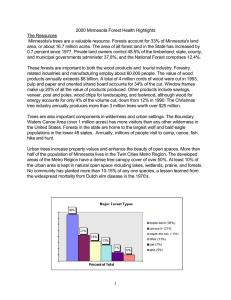Pseudopityophthorus minutissimus
advertisement
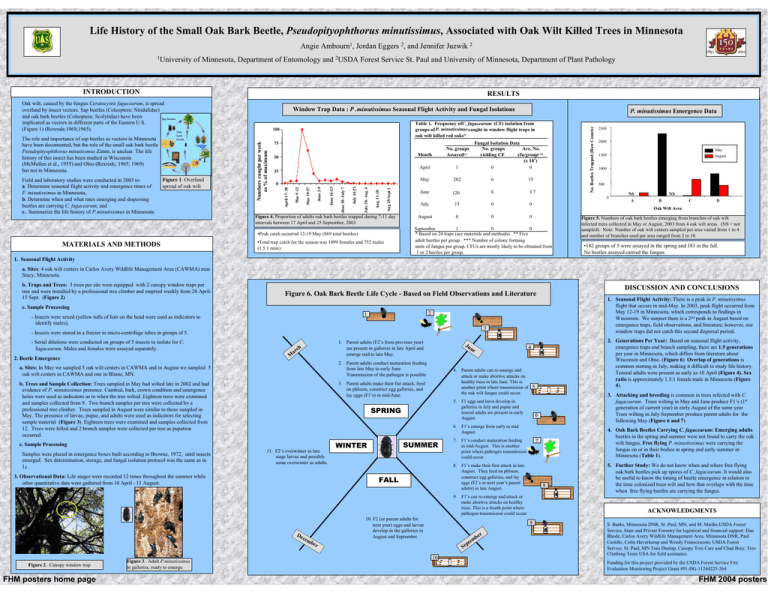
Life History of the Small Oak Bark Beetle, Pseudopityophthorus minutissimus, Associated with Oak Wilt Killed Trees in Minnesota Angie Ambourn1, Jordan Eggers 2, and Jennifer Juzwik 2 1University of Minnesota, Department of Entomology and 2USDA Forest Service St. Paul and University of Minnesota, Department of Plant Pathology INTRODUCTION RESULTS Oak wilt, caused by the fungus Ceratocystis fagacearum, is spread overland by insect vectors. Sap beetles (Coleoptera: Nitidulidae) and oak bark beetles (Coleoptera: Scolytidae) have been Sap beetles implicated as vectors in different parts of the Eastern U.S. (Figure 1) (Rexrode,1968;1965). Oak Aug. 11-18 Aug 25-Sept 1 July 14-21 July 28- Aug. 4 June 30- July 7 June 2-9 May 5-12 June 16-23 0 Figure 4. Proportion of adults oak bark beetles trapped during 7-11 day intervals between 17 April and 25 September, 2003 •Total trap catch for the season was 1099 females and 752 males (1.5:1 ratio) April 1 May 282 6 15 June 120 8 3.7 July 15 0 0 August 0 0 0 No. Beetles Trapped (Raw Counts) 25 •Peak catch occurred 12-19 May (869 total beetles) MATERIALS AND METHODS No. groups Assayed** Month 50 May 19-27 Figure 1. Overland spread of oak wilt Fungal Isolation Data No. groups Ave. No. yielding CF cfu/group*** 2 (x 10 ) 0 0 75 April 17- 28 Field and laboratory studies were conducted in 2003 to: a. Determine seasonal flight activity and emergence times of P. minutissimus in Minnesota, b. Determine when and what rates emerging and dispersing beetles are carrying C. fagacearum, and c. Summarize the life history of P.minutissimus in Minnesota. P. minutissimus Emergence Data Table 1. Frequency ofC. fagacearum (CF) isolation from groups of P. minutissimuscaught in window flight traps in oak wilt killed red oaks* 100 bark beetle Numbers caught per week as % of maximum The role and importance of sap beetles as vectors in Minnesota have been documented, but the role of the small oak bark beetle Pseudopityophthorus minutissmus Zimm, is unclear. The life history of this insect has been studied in Wisconsin (McMullen et al., 1955) and Ohio (Rexrode, 1965; 1969) but not in Minnesota. Window Trap Data : P .minutissimus Seasonal Flight Activity and Fungal Isolations 2500 2000 May August 1500 1000 500 0 NS A NS B C D Oak Wilt Area September 1 0 0 * Based on 24 traps (see materials and methods). ** Five adult beetles per group. *** Number of colony forming units of fungus per group. CFUs are mostly likely to be obtained from 1 or 2 beetles per group. Figure 5. Numbers of oak bark beetles emerging from branches of oak wilt infected trees collected in May or August, 2003 from 4 oak wilt areas. (NS = not sampled). Note: Number of oak wilt centers sampled per area varied from 1 to 4 and number of branches used per area ranged from 2 to 10. •182 groups of 5 were assayed in the spring and 183 in the fall. No beetles assayed carried the fungus. 1. Seasonal Flight Activity a. Sites: 4 oak wilt centers in Carlos Avery Wildlife Management Area (CAWMA) near Stacy, Minnesota. b. Traps and Trees: 3 trees per site were equipped with 2 canopy window traps per tree and were installed by a professional tree climber and emptied weekly from 28 April15 Sept. (Figure 2) DISCUSSION AND CONCLUSIONS Figure 6. Oak Bark Beetle Life Cycle - Based on Field Observations and Literature 1. Seasonal Flight Activity: There is a peak in P. minutissimus flight that occurs in mid-May. In 2003, peak flight occurred from May 12-19 in Minnesota, which corresponds to findings in Wisconsin. We suspect there is a 2nd peak in August based on emergence traps, field observations, and literature; however, our window traps did not catch this second dispersal period. c. Sample Processing 2 1 - Insects were sexed (yellow tufts of hair on the head were used as indicators to identify males). 3 - Insects were stored in a freezer in micro-centrifuge tubes in groups of 5. - Serial dilutions were conducted on groups of 5 insects to isolate for C. fagacearum. Males and females were assayed separately. M 2. Beetle Emergence ch ar Ju ne 2. Parent adults conduct maturation feeding from late May to early June. Transmission of the pathogen is possible a. Sites: In May we sampled 5 oak wilt centers in CAWMA and in August we sampled 5 oak wilt centers in CAWMA and one in Blaine, MN. 5. F1 eggs and larva develop in galleries in July and pupae and teneral adults are present in early August. SPRING 6. c. Sample Processing 11. F2’s overwinter as late stage larvae and possibly some overwinter as adults. 3. Observational Data: Life stages were recorded 12 times throughout the summer while other quantitative data were gathered from 10 April - 11 August. SUMMER WINTER Figure 2. Canopy window trap FHM posters home page Figure 3. Adult P.minutissimus in galleries, ready to emerge. 6 8 F1’s can re-emerge and attack or make abortive attacks on healthy trees. This is a fourth point where pathogen transmission could occur. 10. F2 (or parent adults for next year) eggs and larvae develop in the galleries in August and September. 10 b em er 5. Further Study: We do not know when and where free flying oak bark beetles pick up spores of C. fagacearum. It would also be useful to know the timing of beetle emergence in relation to the time colonized trees wilt and how that overlaps with the time when free flying beetles are carrying the fungus. ACKNOWLEDGMENTS 9 pt Se 4. Oak Bark Beetles Carrying C. fagacearum: Emerging adults beetles in the spring and summer were not found to carry the oak wilt fungus. Free flying P. minustissimus were carrying the fungus on or in their bodies in spring and early summer in Minnesota (Table 1). 7 7. F1’s conduct maturation feeding in mid-August. This is another point where pathogen transmission could occur. 9. 3. Attacking and breeding is common in trees infected with C. fagacearum. Trees wilting in May and June produce F1’s (1st generation of current year) in early August of the same year Trees wilting in July-September produce parent adults for the following May (Figure 6 and 7). F1’s emerge from early to mid August. 8. F1’s make their first attack in late August. They feed on phloem, construct egg galleries, and lay eggs (F2’s or next year’s parent adults) in late August. FALL De cem ber 2. Generations Per Year: Based on seasonal flight activity, emergence traps and branch sampling, there are 1.5 generations per year in Minnesota, which differs from literature about Wisconsin and Ohio. (Figure 6). Overlap of generations is common starting in July, making it difficult to study life history. Teneral adults were present as early as 10 April (Figure 4). Sex ratio is approximately 1.5:1 female:male in Minnesota (Figure 4). 4 4. Parent adults can re-emerge and attack or make abortive attacks on healthy trees in late June. This is another point where transmission of 5 the oak wilt fungus could occur. 3. Parent adults make their fist attack, feed on phloem, construct egg galleries, and lay eggs (F1’s) in mid-June. b. Trees and Sample Collection: Trees sampled in May had wilted late in 2002 and had evidence of P. minutissimus presence. Cambial, bark, crown condition and emergence holes were used as indicators as to when the tree wilted. Eighteen trees were examined and samples collected from 9. Two branch samples per tree were collected by a professional tree climber. Trees sampled in August were similar to those sampled in May. The presence of larvae, pupae, and adults were used as indicators for selecting sample material (Figure 3). Eighteen trees were examined and samples collected from 12. Trees were felled and 2 branch samples were collected per tree as pupation occurred. Samples were placed in emergence boxes built according to Browne, 1972, until insects emerged. Sex determination, storage, and fungal isolation protocol was the same as in 1c. 1. Parent adults (F2’s from previous year) are present in galleries in late April and emerge mid to late May. S. Burks, Minnesota DNR, St. Paul, MN, and M. Mielke,USDA Forest Service, State and Private Forestry for logistical and financial support. Dan Rhode, Carlos Avery Wildlife Management Area, Minnesota DNR, Paul Castillo, Colin Haverkamp and Wendy Franscesconi, USDA Forest Service, St. Paul, MN Tom Dunlap, Canopy Tree Care and Chad Brey, Tree Climbing Team USA for field assistance. Funding for this project provided by the USDA Forest Service Fire Evaluation Monitoring Project Grant #01-DG-11244225-264 FHM 2004 posters

